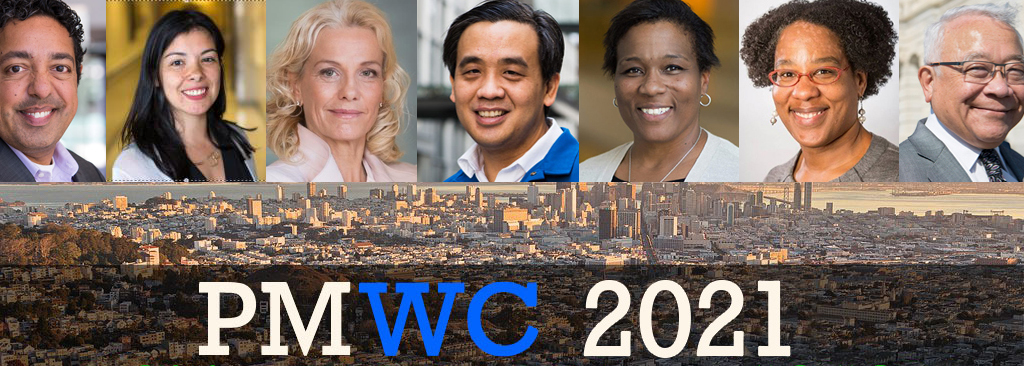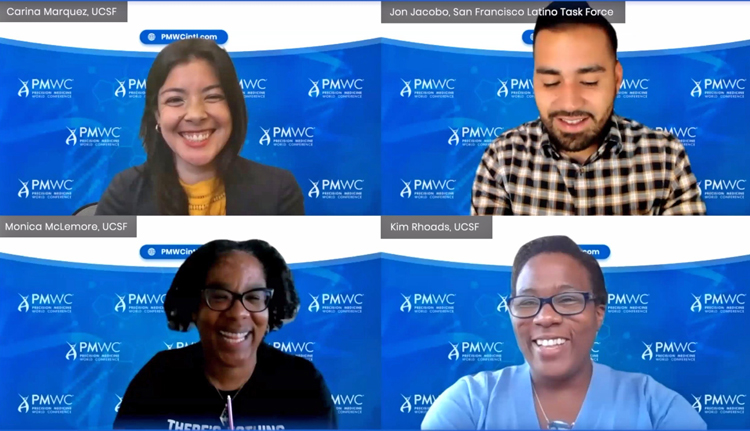
By Sarah Paris
At the recent June Precision Medicine World Conference, scientists and health experts from academia, government, and industry discussed how a precision medicine approached has helped to curb the pandemic and how lessons learned can be used to build resilience against future threats.
UC San Francisco, a leader in in developing and pursuing precision medicine strategies, was once again strongly represented with experts spanning the full spectrum of precision medicine, from basic science and clinical implementation to computational and precision population health.
Highlights of the conference included:
Empowering Public Health Through Data
Atul Butte, MD, PhD, director of the UCSF Bakar Computational Health Sciences Institute, chaired a panel of leading health data experts reflecting on the process of extracting, combining, and applying Electronic Health Record information to inform the response to COVID-19. The urgency to act forged unprecedented collaborations between clinicians, researchers, data scientists, and IT professionals. However, the pandemic also made it clear that interoperability remains a major obstacle for data exchanges in between and even within health systems.
Among the suggestions on how to better prepare for the future, specifically in California, was the centralization of data at the state rather than at the county level. “This would make it possible to supply better data to both state and county public health leaders, as well as the health systems, many of which span multiple counties,” argued Christopher Longhurst, MD, Chief Information Officer at UC San Diego Health.
Atul Butte, who also serves as Chief Data Scientist for UC Health, pointed out that it wasn’t just health professionals who were eager for more information about the pandemic. The daily COVID-19 dashboard, published by the UC Health Twitter account, has regularly received tens of thousands of views. “The public really wants to see data from our health systems,” Butte said.
Bi-directional Community Engagement
Data also revealed from the outset how inequities exacerbated the pandemic. A panel of UCSF and community engagement leaders, chaired by Monica McLemore, RN, PhD, and including Carina Marquez, MD, Kim Rhoads, MD, MPH, and Jon Jacobo of Latino Task Force, discussed the foundations needed to build effective partnerships with local populations and enable better access to vital health care and information. True collaborations, the panelists agreed, are not to be jumpstarted during an emergency but require long-term commitments to build the trust that has often been stunted by historic exploitation. Humility and a bi-directional approach were cited as essential.
Successful strategies mentioned included having community representatives being front and center during outreach, so people could feel engaged by neighbors and friends, and linking engagement to on-site care to overcome barriers to access.
All panelists stressed the need for institutions to make significant investments, pay community partners for their time and effort, and enable faculty to be an ongoing presence in the community. Equally important is the assurance that the research will directly benefit the populations involved. “Globally, there is a lot of work in precision medicine around genomic and transcriptional signatures,” said Carina Marquez, a UCSF assistant professor of medicine who is engaged in global health as well as with local populations. “This research should be tied to a commitment that the innovations that come out of it will be accessible to the affected communities and really benefit the health of people.”

Virus Tracking / New Variants
Genetic sequencing has revolutionized clinical microbiology and the way infectious diseases are diagnosed and tracked. UCSF virologist and professor of laboratory medicine Charles Chiu, MD, PhD, has been at the forefront of tracing the spread of COVID-19 in California. In a panel that included representatives from the Centers for Disease Control, the UK government, and industry scientists, Chiu argued that testing for variants is needed in order to guide infection control measures and provide actionable information to clinicians for managing their patients. “Without knowing which new variants are circulating, it is impossible to take the appropriate public health measures,” Chiu states.
In the case of the California variants, scientists were able to rapidly develop a model to assess infectivity and resistance to neutralizing antibodies from naturally acquired infections or vaccines. New infections, at least in California, are mainly from variants, and Chiu thinks that these will likely persist even in a post-vaccination era.
Precision Medicine in Cancer Diagnosis
New technologies in cancer testing are a tangible example of precision medicine that can immediately benefit individual patients. At the same time, these technologies present complexities that require careful navigation in the clinic. As the only clinician among a panel of speakers from pharmaceutical companies, UCSF oncologist Pamela Munster, MD, pointed out that a positive outcome relies on matching the right test with the right drug for an individual patient, and that the costs of such tests and their reimbursement are major consideration for patients. Similarly, advertising and social media may create expectations that must be managed through discussions with patients, so they understand the pros and cons and applicability of specific tests.
“It sounds great to have early cancer detection, but it comes with a lot of challenges, such as false-positives that could potentially result in years of anxiety in a patient,” Munster said. “It remains crucial to continue to educate ourselves as physicians on the details of each test, and offer guidance to patients tailored to individual circumstances.”
A Systematic Look at Payers’ Perspectives
There is little doubt that the ability to improve prevention and early diagnosis, and the control or cure of disease will ultimately reduce healthcare costs. Yet with so many new and untested technologies hitting the markets, payers are not unreasonably looking for proof of their value before they consider reimbursement.
In a fireside chat, UCSF Director of Precision Medicine Keith Yamamoto, PhD, interviewed Harold Paz, MD, EVP and chancellor for health affairs at Ohio State and CEO of the Ohio State Wexner Medical Center. As the former EVP and chief medical officer at Aetna, Paz has a unique handle to understand both the perspectives of payers and of health care systems.
The precision medicine model seeks to gather and aggregate data across many systems, whether these data are directly actionable or not. Insurers, on the other hand, are looking for cost-effective tests and technologies that will directly lead to impactful interventions. While the industry is mainly driven by market forces, Paz pointed out potential benefits for patients. “We all want to avoid the kind of diagnostic paths where we get test results that are not meaningful but will trigger more tests and procedures. We want to make sure these diagnostic odysseys don’t harm patients.”
Hence, payers expect experimental interventions to first get tested in clinical trials, whose costs are covered by grants or other funding. An in-between approach is available to large health system like Ohio State, which has its own health insurance. “This allows for more flexibility to gain best practices and the opportunity to move from a fee-for-service to a value-based system,” Paz noted.
He agreed with Yamamoto that momentum is clearly building towards greater use and acceptance of precision medicine. “We are seeing collaborations among researchers, clinicians, and payers where expanding data collection and aggregation of that data is hastening the arrival of the needed evidence to support it.”
In his closing comments, Yamamoto rallied for further adoption of precision medicine, especially in large academic centers, multi-site hospital networks, and community hospitals. “We need to engage with rural and underrepresented communities which means we have to overcome challenges such as making data more racially diverse, making technologies easier to use and more accessible, and developing and hiring a diverse workforce.”
* * *
Recordings of the full sessions mentioned are available to the UCSF community only via the links below (requires MyAccess)
|
Use of Electronic Health Records to Support a Public Health Response to the COVID-19 Pandemic |
Atul Butte |
|
Achieving Precision Medicine’s Full Potential Through Community Engagement |
Monica McLemore Jon Jacobo Carina Marquez Kim Rhoads |
|
Charles Chiu |
|
|
Pamela Munster |
|
|
Keith Yamamoto, with Harold Paz |
